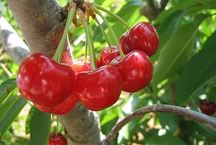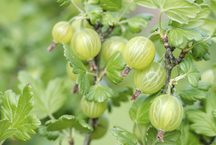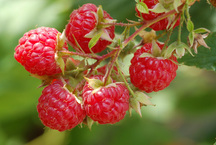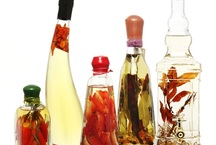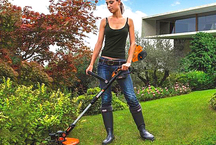8 best grape varieties


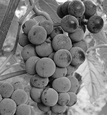


Grapes - capricious thermophilic vine. But tasty and healthy berries justify any efforts to grow. Industrial vineyards are concentrated in the south of Russia, but the winegrowers successfully cultivate the culture in the Urals in greenhouse conditions. Whether the first experience of growing grapes will be successful depends on the right choice of good varieties. In the Moscow region and the Central zone is important not only the winter resistance of the variety, but also the ripening period of the grapes. Forms with a long growing season simply do not have time to mature and form a full brush. We offer you an overview of the best grapes, compiled from reviews of experienced winegrowers and amateur gardeners.
What grape varieties are there?
Grape varieties have a complex classification. As agrotechnology and purpose of the harvest emit technical and dining rooms. If the first, giving small sourish berries for processing, grow well and bear fruit without fertilizers, then the second, forming large beautiful brushes, require a high level of agricultural technology. The table varieties are inferior to technical ones for resistance to major diseases.
By frost resistance distinguish covering and uncovered forms. They differ somewhat in terms of shaping and care. This distribution is valid only for a specific climate zone or even a region. The same grape variety in Volgograd can be grown without shelter, and in the Moscow region already need protection. Also varieties are grouped by the color of the berries and the severity of nutmeg on the palate.
Wine growers with years of experience find it difficult to identify the top ten of the best grapes, because each group will have its own favorites. At the same time, there are no perfect varieties without flaws: for excellent taste and large, beautiful clusters have to pay susceptibility to disease and a tendency to cracking. All table varieties in the spring are treated with fungicides for prophylaxis, and less resistant varieties are sprayed in the summer. The varieties presented below are always present at gardening exhibitions and are most often recommended to beginner growers.
Rating of the best table grapes
| Category | A place | Name | Rating | Price |
|---|---|---|---|---|
| The best early grapes | 1 | Laura | 9.9 / 10 | 175 |
| 2 | Arcadia | 9.9 / 10 | 175 | |
| 3 | Alyoshenkin | 9.8 / 10 | 450 | |
| 4 | Somerset Sidlis | 9.7 / 10 | 200 | |
| 5 | Zilga | 9.6 / 10 | 520 | |
| The best mid-season grapes | 1 | Talisman (Kesha-1) | 9.8 / 10 | 175 |
| 2 | Kishmish radiant | 9.7 / 10 | 270 | |
| 3 | Rizamat | 9.7 / 10 | 250 |
The best early grapes
|
Laura
175 (for one-year own-rooted seedling of 1st grade)
Very early table grapes Odessa selection. Bush srednerosly, poorly stepson. The cluster is conical, often friable, weighing more than 1 kg. The berries are cylindrical, up to 4 cm long, weighing 6 to 9 g on average, greenish-white, sometimes with tan. The flesh is dense, crunchy, the skin is strong, thin, with a waxy coating. Attaching to the stem is durable, the bunch does not crumble. Berries accumulate sugars well and quickly lose acids, there is a muscat flavor. In favorable years and with good care, one plant gives 60 - 70 kg of berries. Shows increased resistance to mildew, is not affected by gray mold. Cracking of the skin is extremely rare. It is well pollinated, but does not tolerate crop overload, therefore its rationing is required. One vine is left in one cluster. In the middle zone is grown with a mandatory cover for the winter. Main advantages:
Minuses:
|
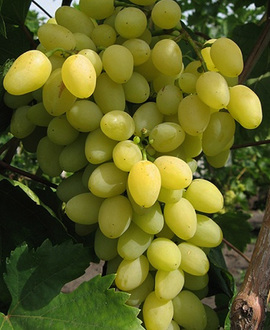 9.9 / 10
Rating
Reviews
I have Laura - the most favorite grape variety.The berry is fleshy, harmonious in taste, hangs on the bushes for a long time and does not deteriorate, it is well stored after removal. |
|
Arcadia
175 (for one-year own-rooted seedling of 1st grade)
Early ripe table grapes with light-colored berries. Bush vigorous. Saplings quickly grow and start fruiting early. In good years, the vine matures well, but crop overload delays ripening. The clusters are dense, weighing 600 grams on average, but with good care they reach 1.5-2 kg, with blades, wide-conic. Berries 2.8 - 3 cm long, weighing from 7 to 15 g, ovoid, amber-white. The flesh is juicy and fleshy, the skin is strong. The taste is simple, with a slight nutmeg aroma at the stage of full ripening. Berries tolerate transportation. Productivity depends on agricultural technology, the method of forming and the age of the bush. Responsive to agricultural practices, including fertilization. Shows resistance to mildew at 3.5 points. Winter hardiness is average, refers to covering. Main advantages:
Minuses:
|
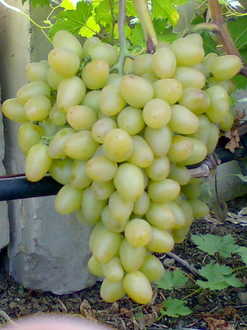 9.9 / 10
Rating
Reviews
In my conditions, this grape variety manifests itself in the best way. It gives large clusters, berries are tasty, the skin is not rough, of medium thickness. |
|
Alyoshenkin
450 (for a two-year sapling with ZKS)
A good early grape variety of the dining form of Volgograd breeding. It is vigorous and highly productive, it takes root quickly and adapts to the microclimate, with a good maturation of the shoots. Cutting done on 5 - 6 or 8 - 10 eyes. The cluster is friable, loosely branching, conical, depending on care, it can weigh from 500 g to 2 kg. Berries are oval, amber colored with a whitish bloom, weighing 4.5 g. The third part (in some years up to 50%) of berries without seeds, responds well to preparations for ramishes. Pulp harmonious taste, crispy. Peel of medium density. Winter hardiness is good, but in the Middle zone requires light cover. It has good adaptive properties, the vine ripens even in adverse years. Due to insufficient disease resistance, it is grown with preventive treatments throughout the season. Main advantages:
Minuses:
|
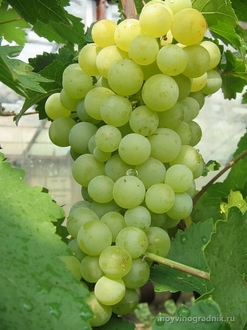 9.8 / 10
Rating
Reviews
We (Nizhny Novgorod region) always have strong dew in the morning, so the bush suffers from mildew. But this problem is solved, and he has many advantages. |
|
Somerset Sidlis
200 (for one-year sapling of 1 grade)
Early seedless variety with brightly colored berries. North American breeding. It is characterized by moderate growth of shoots. A cluster of medium size or small, weighing 100 - 200 g, dense, cylindrical. The berries are round, weighing 1 - 2 g, pink. Taste is rated very high. The skin is medium density, strong, eaten. Adapted for the northern regions. It has high winter hardiness and good immunity. In regions with winter temperatures not lower than minus 20 - 25 degrees, it can be grown in a non-covering culture. When grown in the Ryazan and Moscow regions, the beginning of ripening is noted in the first decade of August. Main advantages:
Minuses:
|
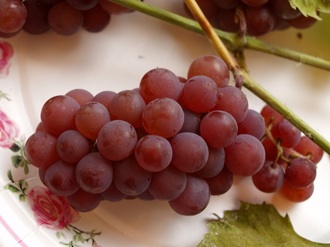 9.7 / 10
Rating
Reviews
For the Moscow region, I think this is the best grape variety, even in bad years it ripens until mid-August, the vine always ripens. Children have the most favorite. |
|
Zilga
520 (for one-year sapling in a container (ZKS))
This early ripening universal grape is good for the Moscow region and for the northern regions. Bushes vigorous. Shoots mature perfectly. Good compatibility with rootstocks, fast rooting.The cluster is cylindrical, with one wing, dense, weighing 300 - 450 g. The berries are round-oval, dark blue, weigh about 4 g. The mucous pulp, the skin is thick. The taste is simple, characterized as isabelny. Ripened clusters can remain on the vine for a long time, without falling off and not losing taste. It is resistant to gray rot, mildew and oidium. Frost resistance is good, but is grown up with shelter for the winter. It is especially appreciated for cold resistance: berries ripen and gain sugar and in regions with insufficient for southern varieties the amount of active temperatures. Positive experience of cultivation obtained by the growers from the Moscow and Leningrad regions. Main advantages:
Minuses:
|
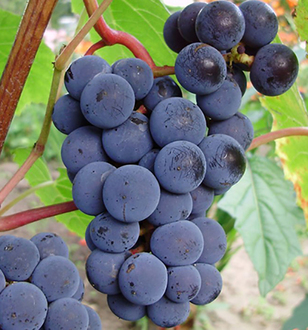 9.6 / 10
Rating
Reviews
The best grape for novice growers: he will forgive any mistakes. Berries are quite edible, if you do not chase the southern standards, and the wine is good. |
The best mid-season grapes
|
Talisman (Kesha-1)
175 (for one-year own-rooted seedling of 1st grade)
Mid-season table grapes. With flowers of a functionally female type, it shows good pollination (with the presence of pollinator varieties) and a low degree of pea, but when dusted, forms a leveled, larger cluster. Differs active growth, shoots are thick and noticeably ahead in growth of other varieties. Pasynkov gives a lot. The cluster is conical, of average density, weighing from 550-800 to 1100-1900. The berries are round, 3 to 4 cm in diameter, amber with a white wax coating, weighing 12 to 16 g and above. The flesh is very sweet, with nutmeg flavor and aftertaste. Shows high resistance to disease and frost. Due to late ripening it is recommended for cultivation in the southern regions. In the Volgograd region ripens in the third decade of August. In the suburbs in the open ground of this grape is marked by poor ripening and the lack of varietal taste of berries. It shows itself well when grown in a greenhouse or with temporary shelters for a “race”. Main advantages:
Minuses:
|
 9.8 / 10
Rating
Reviews
The variety is not easy, you have to tinker with it, but the taste of the berries and good resistance to diseases outweigh its capriciousness. |
|
Kishmish radiant
270 (for one-year sapling of 1 grade)
Seedless variety of medium ripening. Bushes vigorous. The clusters are cone-shaped, branchy, 40 cm long, often with lobes, of average density, average weight of 500 - 600 g. Oval berries, 2.5 - 3 cm long, weight of 2.5 - 4 g, pink-red. The pulp is dense, sugary with a light nutmeg. Suitable for transportation and long-term storage. In the spring, buds wake up later than early varieties. Not suitable for cultivation in the Central region. In the Moscow region in the open field does not ripen. In the Voronezh region in the rainy summer does not gain sugar. Good reviews of winegrowers from the Volgograd region, where it is grown in a covering culture. Main advantages:
Minuses:
|
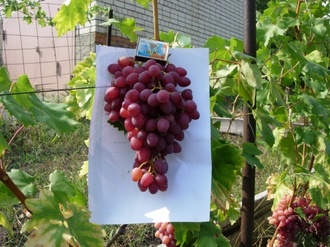 9.7 / 10
Rating
Reviews
Having tasted berries at the exhibition, I was very burnt by this sort. Yes, it requires attention, but, like all kishmishis, out of competition, to the taste and beauty of the bunch. |
|
Rizamat
250 (for one-year own-rooted seedling of 1st grade)
Mid-season table-raisin grapes of Uzbek selection. Bush with a high growth force. Requires careful shaping, be sure to remove stepsons. The cluster is cone-shaped, branchy, of average density, weighs 800 to 1500 g, with professional care, the weight of individual clusters exceeds 3 kg. The berries are cylindrical, weighing 10 - 15 g, pink with a darker tan, with an average wax coating. The flesh is tender, dense, crisp. The skin is thin.Experienced growers from an adult bush collect more than 70 kg. Does not possess complex stability and needs frequent prophylactic treatments. Ripening berries attract wasps, so the clusters are protected. After heavy rains, the berries have cracked skin. Forms high yields under the condition of high soil fertility. Due to the low frost resistance, even in the Central zone, a good shelter is needed, in the Moscow region it is more often grown in greenhouses. Main advantages:
Minuses:
|
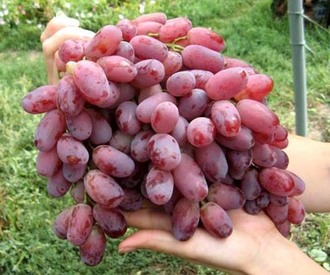 9.7 / 10
Rating
Reviews
The variety definitely justifies heightened attention. All care efforts pay off with a large and beautiful berry with a delicate flavor and crisp flesh that simply melts in your mouth. |
The price of grapes cuttings is 2, and sometimes 4 times lower than the price of ready-made seedlings. Depending on the variety and manufacturer, cuttings can cost from 50 to 300 rubles. On the forums you can find private growers who donate several cuttings. But planting cutting implies scrupulous care, and great risks.
Have a good harvest!
